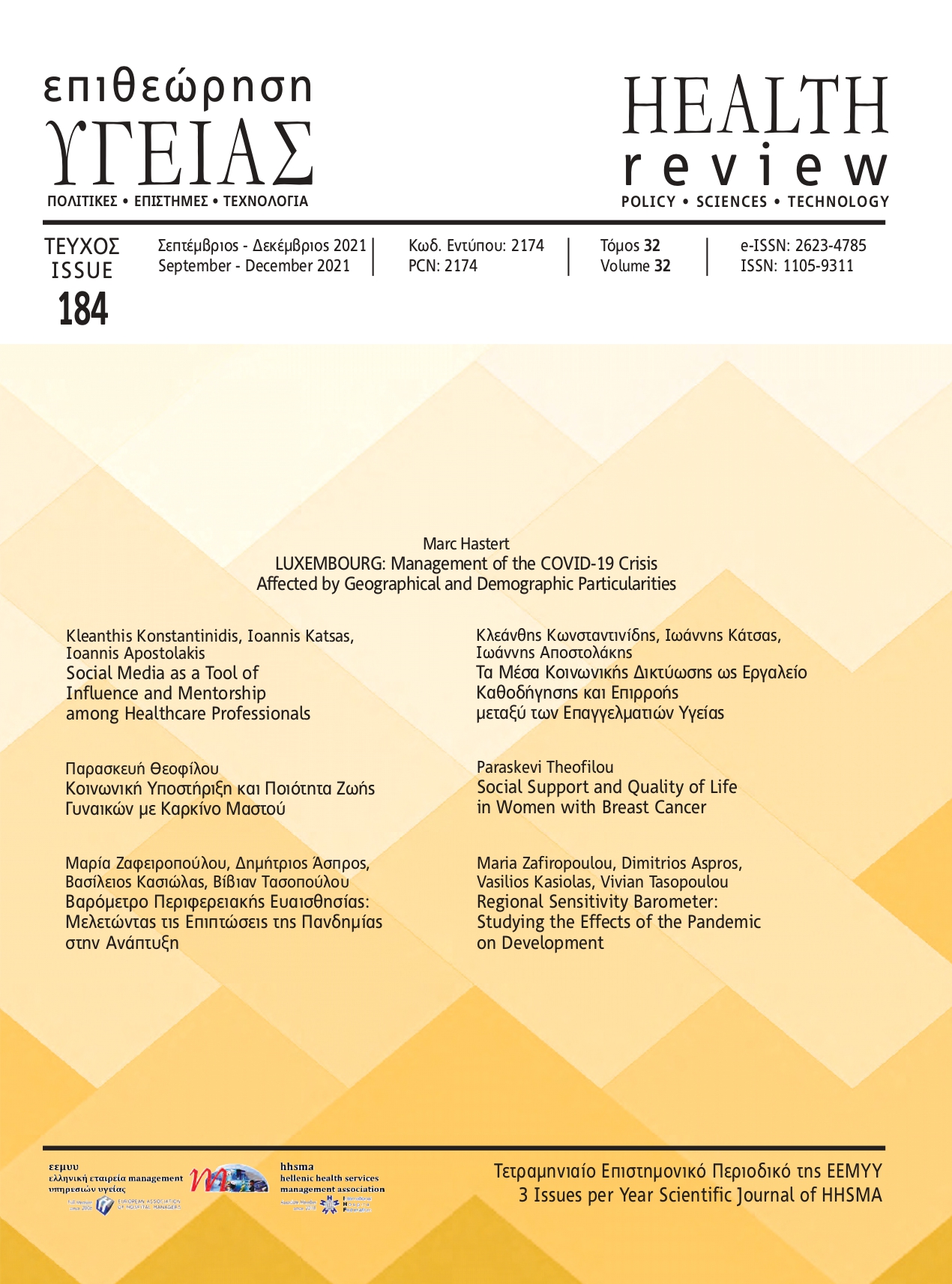
3 Issues per Year Scientific Journal of HHSMA
Editor in Chief: Georgia Oikonomopoulou MSc, PhD(c), Chair of HHSMA Board, Board Member of EAHM
Latest Published Articles
Introduction: The use of Social Media (SoMe) by healthcare professionals (HCPs) has risen fast in the recent years, creating a new informal framework of collaborative intelligence, which is based on the virtual interaction of its users. In addition, COVID-19 pandemic has accelerated SoMe usage from HCPs, who explore alternative avenues to professional development and ways to navigate the volume, veracity and variety of data and networks in a currently shaping SoMe environment in healthcare. Objective: The revelation of SoMe as a means for communicating with peer networks and an opportunity for mentorship and coaching, as well as information sharing and remote collaboration to promote professional development. Method: We conducted a literature search in PubMed and Google Scholar online databases for the last five years (2016-2021) using keywords. Keywords used were “social media”, “healthcare”, “healthcare professionals”, “mentorship”, “coaching”, “influence”. Snowball referral sampling method was also utilized for further review. Results: We identified 18 articles. Twitter, the most commonly used platform amongst HCPs, allows real-time engagement and dissemination of information. Collaborative Web 2.0 tools are also utilized to support mentorship, influence and coaching amongst HCPs. Conclusion: HCPs begin to take ownership in shaping the future of SoMe usage in healthcare field. SoMe can be useful for sharing information, mentorship amongst HCPs and a means for their professional development. Although HCPs adopt the use of SoMe, questions arise about the proper and ethical use of them. Certain conditions must be met before their usage, in order to avoid any risk of misinformation, dispute of information’s reliability, distrust of persons and conflicts of interest.
Introduction: Social support for women with breast cancer is linked to quality of life (QoL) and appears to be vital in treating breast cancer and adapting to the disease. Purpose: The purpose of the present study is the investigation of differences in social support and QoL levels in women with breast cancer (i) during chemotherapy and (ii) two years after chemotherapy. Method: In this cross-sectional study, 74 women with breast cancer participated in two independent groups of patients. Specifically, during chemotherapy (n = 41) and two years after chemotherapy (n = 33). The participants in the study completed the Greek version of the Multidimensional Perceived Social Support Scale (MSPSS) as well as the Greek version of the Missoula-VITAS Quality of Life Index (MVQoLI-15) for measuring social support and quality of life respectively. All statistical analyses were performed with the statistical program SPSS 25. Results: The group "two years after chemotherapy" reported better QoL than the group "during chemotherapy". There was no difference in perceived social support between the two groups. The older the patients, the lower the QoL for the chemotherapy group. Conclusions: Research findings indicate that quality of life improves over time.
The regional sensitivity barometer evaluates the regional sensitivity of European regions and the regional needs amid the CoViD-19 health and financial crisis. In this paper qualitative and quantitative indicators were combined in European level and then an overall sensitivity index was calculated for each average European region. Demographic, economic, health, tourism-related and CoViD-19 pandemic-related data are taken into account, using differentiated weighting factors. Τhe statistical data used was lastly evaluated on December 31st, 2020 in Eurostat database and processed in order to create the regional sensitivity for every country. The total index highlighted the final ranking between the European regions and formed the basis for the depiction of sensitivity on the European map. A series of conclusions came up; namely the existence of three groups of European Union (EU) member states in terms of regional resilience amid the CoViD-19 crisis, as well as the extreme sensitivity of regions that later faced significant difficulty in handing the health and financial crisis, such as Portugal, Greece, Italy and the United Kingdom. In addition, Slovak Regions have shown preparedness to health threats. Comparing barometer results becomes clear that the sensitivity of a region is inextricably linked to its course over time, the chronic systemic pathogens and the readiness that has already developed in emergencies.
The Grand Duchy of Luxembourg is a small country with a surface area of 65.401 km2, situated between Belgium, France and Germany. The country has just over 630.000 inhabitants who are fluent in several languages: Lëtzebuergesch, French, German, English for the most part and Portuguese by Portuguese immigrants representing approximately 17% of the population. The country is located at the centre of a population basin of more than 11 million inhabitants, called the "Grande Région", with an area of 65.401 km2 The Grand Duchy of Luxembourg therefore welcomes a growing number of cross-border commuters who work in Luxembourg. Of the 477.452 active workers, 262.490 are residents and 214.962 (45%) are cross border commuters. The cross-border commuters are distributed as follows according to their country of origin: Belgium 51.000; Germany 53.000; France 112.000. A large number of these cross-border commuters work in the health sector (Table 1) and in particular in the hospital sector. Of the 13.769 healthcare workers in the hospital sector, some 7.800 people are cross border commuters, i.e. 56% of the workers in the hospital sector. These cross-border commuters are currently distributed as follows, according to their country of origin: Belgium 1.687 persons; Germany 2.712 persons and France 3.370 persons.
